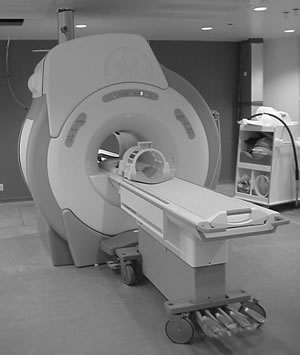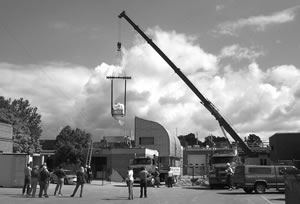ARCHIVE EQUINE NEWS STORIES
| Current news is available at TheHorsePortal.ca, Equine Guelph's online learning platform for practical, quick learning. Given the vast amount of information on horse health and welfare, Equine Guelph has archived its past news articles from 2002-2020. They are listed below, along with a search function available to find specific healthcare topics. | |
MRI technology now available at OVCNovember 2004
After more than 10 years of fundraising and planning, OVC is celebrating the opening of a new facility for Magnetic Resonance Imaging (MRI). Renovations and construction began last fall, and the completed facility passed into OVC hands in mid-October.The new MRI equipment allows OVC to expand research efforts, clinical diagnosis and treatment of animals at the Veterinary Teaching Hospital by giving clinicians the best possible detail of soft tissue inside an animal's body.
"This will make a huge difference in our ability to diagnose and treat cases," says Dr. Howard Dobson, a radiologist in the Department of Clinical Studies. Dobson says that MRI will be used in applied research and clinical diagnosis of illnesses as varied as epilepsy, cancer, arthritis and visual impairments.
At peak capacity, the Veterinary Teaching Hospital could perform six MRIs per day, each patient requiring between one and two hours for imaging. Magnetic Resonance Imaging will cost about $700 to $900 per animal (not including the cost of anesthesia), a price which represents the cost of maintaining the expensive equipment and paying for specialists to operate it.
The majority of clinical cases will also be part of prospective research studies. While there is no difference in the care or treatment an animal receives, this type of study allows researchers to learn more about illnesses such as cancer and spinal cord disease by studying MRIs from animal patients.
"It's limitless," says Dobson, referring to the research potential of MRI. "The advantage of MRI is that its cross-sectional resolution results in better anatomical images." Another benefit of MRI is its versatility: in addition to anatomical imaging, the equipment can produce pathological images, allowing clinicians to identify healthy and diseased tissue, and perfusional studies quantifying the amount of blood flow in a lesion.
"The information from MRI can be very specific, such as the exact measures of a tumour’s size and how blood flows to the site," Dobson says.
MRI uses a powerful magnetic field to detect the nature of the chemical bonds between the atoms in the body, and uses this information to create images. The MRI's significance as a diagnostic tool is its ability to produce a "living gauge" of bone, soft tissue and cartilage. MRI varies from other diagnostic technologies such as radiographs or nuclear scintigraphy because of its ability to detect subtle changes in bone, soft tissue and cartilage. For example, bone bruises, not normally identified through other imaging technologies, can be detected using MRI.
OVC's MRI facility is one of a few world-wide that can accommodate a wide range of animal patients, including cats, dogs, pigs, horses and sheep. The unit, which is the same as one used for humans, can take images of a whole dog or foal. The MRI unit can image the head and neck of an adult horse, as well as up to the knee of the front legs and the hock in the rear.
The MRI was supported by the Pet Trust Fund and through funds provided by the Canada Foundation for Innovation and the Ontario Innovation Trust for a new Institute for Animal-Human Links in Health Science Research.
- Karen Gallant
Common patients of OVC’s MRI unit will include:
- high performance horses with lameness
- dogs with spinal cord disease
- animals with diseases of the central nervous system
- dogs and cats with tumours
Above: On August 6, the powerful magnet that is part of OVC’s new Magnetic Resonance Imaging unit was lowered into the facility.
Below: OVC's MRI unit is ready for its first patient.

